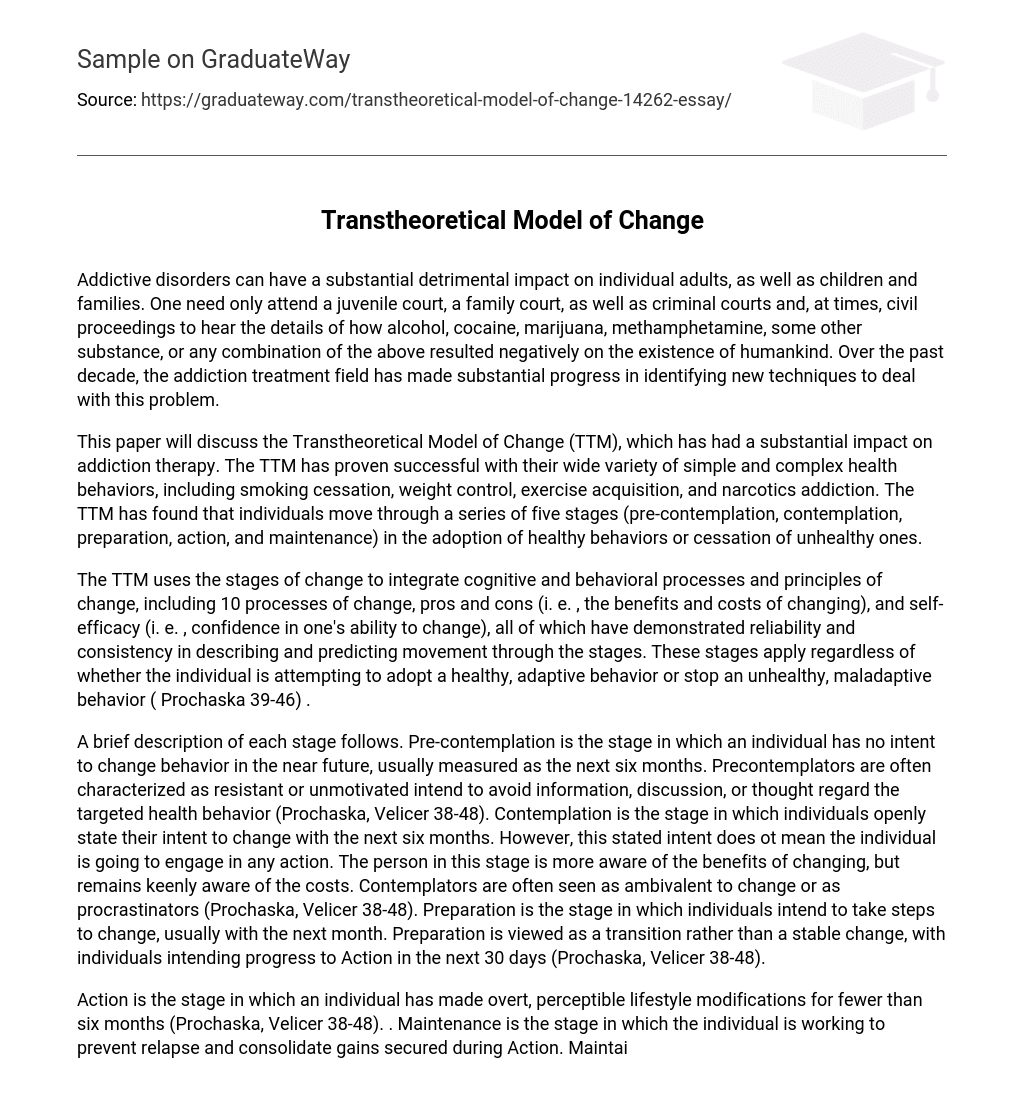Addictive disorders can have a substantial detrimental impact on individual adults, as well as children and families. One need only attend a juvenile court, a family court, as well as criminal courts and, at times, civil proceedings to hear the details of how alcohol, cocaine, marijuana, methamphetamine, some other substance, or any combination of the above resulted negatively on the existence of humankind. Over the past decade, the addiction treatment field has made substantial progress in identifying new techniques to deal with this problem.
This paper will discuss the Transtheoretical Model of Change (TTM), which has had a substantial impact on addiction therapy. The TTM has proven successful with their wide variety of simple and complex health behaviors, including smoking cessation, weight control, exercise acquisition, and narcotics addiction. The TTM has found that individuals move through a series of five stages (pre-contemplation, contemplation, preparation, action, and maintenance) in the adoption of healthy behaviors or cessation of unhealthy ones.
The TTM uses the stages of change to integrate cognitive and behavioral processes and principles of change, including 10 processes of change, pros and cons (i. e. , the benefits and costs of changing), and self-efficacy (i. e. , confidence in one’s ability to change), all of which have demonstrated reliability and consistency in describing and predicting movement through the stages. These stages apply regardless of whether the individual is attempting to adopt a healthy, adaptive behavior or stop an unhealthy, maladaptive behavior ( Prochaska 39-46) .
A brief description of each stage follows. Pre-contemplation is the stage in which an individual has no intent to change behavior in the near future, usually measured as the next six months. Precontemplators are often characterized as resistant or unmotivated intend to avoid information, discussion, or thought regard the targeted health behavior (Prochaska, Velicer 38-48). Contemplation is the stage in which individuals openly state their intent to change with the next six months. However, this stated intent does ot mean the individual is going to engage in any action. The person in this stage is more aware of the benefits of changing, but remains keenly aware of the costs. Contemplators are often seen as ambivalent to change or as procrastinators (Prochaska, Velicer 38-48). Preparation is the stage in which individuals intend to take steps to change, usually with the next month. Preparation is viewed as a transition rather than a stable change, with individuals intending progress to Action in the next 30 days (Prochaska, Velicer 38-48).
Action is the stage in which an individual has made overt, perceptible lifestyle modifications for fewer than six months (Prochaska, Velicer 38-48). . Maintenance is the stage in which the individual is working to prevent relapse and consolidate gains secured during Action. Maintainers are distinguishable from those in the Action stage and they report the highest levels of self-efficacy and are less frequently in the relapse (Prochaska, Velicer 38-48). It should be noted that these phases do not follow a simple linear progression.
Relapse is a common and expected occurrence in addiction recovery. Therefore, the stages are seen as a set of dynamically interacting components for which the individual will likely cycle a number of times before achieving sustained behavior change (Prochaska, Velicer 38-48). Works Cited Prochaska, J. O. “13. ” Stages of Change and Decisional Balance for 12 Problem Behaviors. 39-46. Print. New York: Farrar 1994 Prochaska, J. O. , and W. F. Velicer. “12. ” The Transtheoretical Model of Health Behavior Change. 38-48. Print. New York: Cassell 1997





